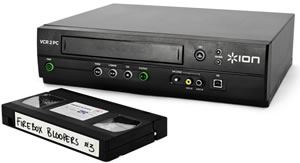 Remember when we broke the story of the USB tape deck?
Remember when we broke the story of the USB tape deck?
The latest bit of USB kit for digitising your media from Firebox is a USB VHS machine.
Devices that are able to pull content and display it on a TV or play it on a HiFi
 Remember when we broke the story of the USB tape deck?
Remember when we broke the story of the USB tape deck?
The latest bit of USB kit for digitising your media from Firebox is a USB VHS machine.
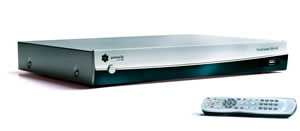 Pinnacle have announced the launch of their Showcenter 250HD. It’s a device that’s been designed to let you enjoy your digital media, but away from your computer.
Pinnacle have announced the launch of their Showcenter 250HD. It’s a device that’s been designed to let you enjoy your digital media, but away from your computer.
You’ll probably have guessed from the HD suffix that the Showcenter 250HD supports HiDef video, as it does with HD resolution photos.
(more…)
 Hollywood has finally embraced the online movie distribution business with the launch of two new digital services that will make films available to download on the same day of their DVD release.
Hollywood has finally embraced the online movie distribution business with the launch of two new digital services that will make films available to download on the same day of their DVD release.
In a move designed to stave off movie piracy – estimated to cost Tinseltown up to 3.5 billion dollars a year – the two competing download services, Movielink and CinemaNow, have announced that they will be making hit films available to download online.
Movielink
The Internet video-on-demand company Movielink was launched back in 2002, and is jointly owned by big name studios Paramount Pictures, Universal Pictures, Sony Pictures Entertainment, Metro-Goldwyn-Mayer (MGM), Warner Bros. and Twentieth Century Fox.
 The company will start offering more than 200 movies for sale online, with Universal’s Oscar-winning “Brokeback Mountain” set to be the first major Hollywood blockbuster to be simultaneously released as a DVD and digital download.
The company will start offering more than 200 movies for sale online, with Universal’s Oscar-winning “Brokeback Mountain” set to be the first major Hollywood blockbuster to be simultaneously released as a DVD and digital download.
Other films due to made available from Movielink are Peter Jackson’s “King Kong,” George Clooney’s Oscar-nominated “Good Night, and Good Luck,” the Johnny Cash story “Walk the Line” and the kids’ favourite “Harry Potter and the Goblet of Fire.”
Rival company CinemaNow has also announced that it will start making movie downloads available from Lions Gate Entertainment and Sony.
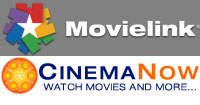 How it works
How it works
The system will let consumers shell out for a permanent digital film library of films, or rent downloaded movies for 24 hours.
Purchased movies can be permanently stored on a computer’s hard drive or saved to a DVD in Windows Media format for backup or playback on up to two additional tethered computers.
For road warriors, movies can also be downloaded to a laptop, with users also able to stream movies to a TV hooked up to a media centre extender or Xbox.
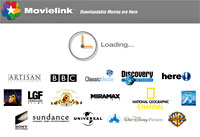 We take a look. And get annoyed
We take a look. And get annoyed
We thought we’d take a quick shufti at the two sites for more information but found Movielink’s site a real wind-up.
After wasting a few moments being forced to circumnavigate their irritating geographical filter (it won’t let you see the site unless your IP address is in the US) the company annoyed us further by insisting that we use ‘IE 5.0 or higher’ to access the site.
No thanks. We choose to use Firefox and resent being told what tools we should use. Oh, and their service is, apparently, Windows only. Grrrr..
 Web browser company Opera today announce they’re bring their Web browser with AJAX support to chips for use in Consumer Electronics (CE) applications.
Web browser company Opera today announce they’re bring their Web browser with AJAX support to chips for use in Consumer Electronics (CE) applications.
It’s not long back that Opera made the decision to give their Web browser away after a long period of charging for it. A very brave and noble act many though – not a bad way to raise your profile we thought.
 They’ve been putting their browsers on different platforms for a while, like the mini-browser for mobile phones they brought out back in August 05.
They’ve been putting their browsers on different platforms for a while, like the mini-browser for mobile phones they brought out back in August 05.
The reasoning behind the give-away move becomes clearer today as they announce that they’ve been working with US chip company Sigma Designs to bring their browser software to embedded hardware via Sigma’s SMP8630 family of chipsets.
![]() Clearly looking to tread on Intel’s toes, Sigma say the SMP8630 family of chipsets can be used in digital media adapters, IPTV set-top boxes and networked DVD players that OEM’s may want to build.
Clearly looking to tread on Intel’s toes, Sigma say the SMP8630 family of chipsets can be used in digital media adapters, IPTV set-top boxes and networked DVD players that OEM’s may want to build.
To get to use the browser and the oh-so-desirable AJAX, OEM’s will need to get in touch with Opera to license their Software Development Kit (SDK). Once familiar with it they should be able to create some snazzy application.
So what’s so exciting about embedded Web browsing software? Their supports the darling of the hour buzzword – AJAX.
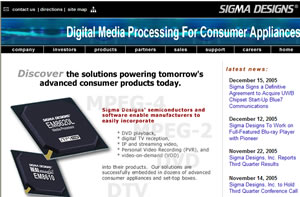 We’re sure you, dear reader, know what AJAX is, but just incase – it stands for Asynchronous JavaScript and XML. This translates to being able to use a Web browser more like a computer-based application.
We’re sure you, dear reader, know what AJAX is, but just incase – it stands for Asynchronous JavaScript and XML. This translates to being able to use a Web browser more like a computer-based application.
The most notable difference from a ‘normal’ Web app is information and updates can be carried out without needing reload the Web page each time. It’s an intergral part of the Web 2.0 landscape.
 The most often cited example is Google’s Gmail.
The most often cited example is Google’s Gmail.
We at Digital-Lifestyles see the rise of AJAX as the event that broke Microsoft’s domination of computers. So pretty significant really.
Expect this news to generate great excitement in the Blog-world.
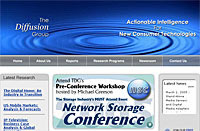 Evidence is beginning to amass that two of the most hyped products in the early digital home market will be lucky if they manage to reach niche market status in the next few years.
Evidence is beginning to amass that two of the most hyped products in the early digital home market will be lucky if they manage to reach niche market status in the next few years.
Not so long ago, people were getting very excited by media servers and digital media adapters. They were the future. And then, err, people kinda forgot about them.
So what happened?
According to new research from The Diffusion Group, it seems that despite the products being well-hyped, widely discussed and blessed with encouraging early forecasts from a number of research firms, the devices have suffered from extremely limited demand.
Moreover, the report concludes that demand for both these technologies will remain limited and that what unique functionality these solutions do offer will be quickly integrated into other platforms.
“It is not that this type of functionality is undesirable,” said Michael Greeson, President of The Diffusion Group. “The premise of networking stored digital media content to multiple devices in the home is valid, but consumers aren’t looking for separate devices to enable this experience.
Instead, the applications and benefits enabled by these two platforms will be increasingly integrated into devices with which consumers are more familiar – such as DVD players that are now evolving into DVD-recorders or set-top boxes with built-in hard-drives and integrated networking.”
“While media servers were originally positioned to be the hub of the digital home, demand for these solutions has never gotten off the ground.”
Although Windows Media Center PCs have proved more popular, Greeson asserts that this is simply down to normal PC replacement cycles rather than consumers finding anything particularly compelling about the concept.
Other media server platforms have been much less successful, although the push of high-end digital set-top boxes by cable and satellite video service providers offers a case for optimism.
“However,” says Greeson, “this is a push model, where the equipment is subsidised by the service provider in order to generate digital media service revenue, as opposed to a ‘pull’ model where consumers are so enamoured with the device that they run to the retail store to purchase one.”
When it comes to digital media adapters or DMAs, the Diffusion Group paints a gloomy picture.
Introduced a couple of years ago, the idea was to make it easy to share content from the PC to other media devices in the home, such as a TV or stereo using a DMA. But their techie-tastic appeal failed to win over punters.
“Not long ago, there were ten to fifteen companies offering DMAs,” said Gary Sasaki, a contributing analyst with The Diffusion Group and President of DIGDIA, a media consultancy.
“At this year’s CES, DMAs were hard to find. Part of the reason for the premature demise of DMAs is that their functionality appeals mostly to early-adopter or technology-savvy buyers. Additionally, and somewhat similar to media servers, the functionality of DMAs is slowly getting integrated into other more familiar product categories.”
The report suggests that we’ve got an industry in fast transition, with early, stand-alone technologies being picked clean for their useful ideas and then incorporated into more consumer-friendly converged products.
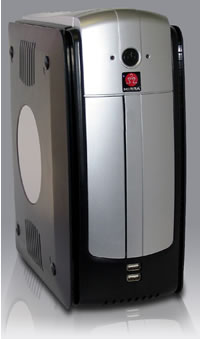 By 2009, consumers will require at least a 57Mbit/s Internet connection speed – up from today’s 3Mbit/s – to meet the demands of an ever-growing collection of always-on home media devices, according to research carried out by Jupiter Research. For tech-savvy consumers, the bandwidth requirement will likely be even higher, as much as 84Mbit/s.
By 2009, consumers will require at least a 57Mbit/s Internet connection speed – up from today’s 3Mbit/s – to meet the demands of an ever-growing collection of always-on home media devices, according to research carried out by Jupiter Research. For tech-savvy consumers, the bandwidth requirement will likely be even higher, as much as 84Mbit/s.
Fuelled by the uptake of home wireless networks, the report, “A Portrait of the Wireless Home in 2009,” tackles a number of key issues; what the average and tech-savvy digital home will look like in 2009; comparing wireless bandwidth requirement of the average home today with 2009. It also poses questions such as with the implementation of compression standards such as H.264, will consumers need 100Mbit/s or 802.11n at home?
The report comes following the four complete and 30 partial proposals that were submitted to the IEEE for consideration for the 802.11n standard in August 2004, which will increase wireless throughput to 100Mbit/s. The 802.11n standard should be ratified in 2006, although pre-standard products are already out on the market.
The study finds a growing reliance on digital media. Home media servers, such as Mirra’s Personal Server (from $399), are growing in popularity because they allow you to access files stored on their hard disk from any Web browser, allowing you to playback video and audio files to a laptop or Wi-Fi enabled TV in your living room, or access family photos at your desk at work.
With the increasing uptake of both on-demand video and audio playback, it’s looking more likely that consumers will access media files stored on a central server in their backroom from multiple-connected devices – especially as the number of consumer electronics devices using a wireless network in the home will explode over the next five years, as people move away from traditionally separate devices, such as PCs and stereos.
802.11g has a theoretical maximum speed of 54Mbit/s, you only tend to get on average about half of that. Although this is still over twice as fast as 802.11b, the original WiFi, home media networks which transmit TV shows and music as well as Internet connectivity to multiple devices will require far more speed and bandwidth than standard Wi-Fi can provide. Standards like 802.11n and Ultra Wide Band (UWB) move closer in the right direction.
Pinnacle ShowCenter is by no means a new kid on the block but its latest version, ShowCenter v1.7 has some new features that make it worth revisiting since it has just been released in the UK.
For starters, Pinnacle ShowCenter is now 802.11g wireless network ready, and includes a compatible wireless module, making it easy to set up ShowCenter on a wired Ethernet, 802.11b or 802.11g home network, and giving it a realistic chance of supporting wireless delivery of audio and video.
Funky new features include the ability to listen to music without turning on the television – users can now assign radio stations or play lists to individual buttons on the ShowCenter remote control. But coolest of all, you can now pause live TV and schedule recordings on your PC.
For the uninitiated, Pinnacle ShowCenter is a set-top device that connects to wireless and wired home local area networks (LAN) allowing streaming of multimedia files from any PC on the network to any television or home entertainment system in the house. It’s really a complete media management software suite for organising and managing media files. Unknown file formats are automatically converted and streamed to the ShowCenter in a recognisable format, while you can control the PVR features on your PCTV tuner from the ShowCenter unit – if you have Pinnacle PCTV Pro, PCTV Stereo, PCTV USB2 or PCTV MediaCenter products.
The ShowCenter software has now been updated with audio and media management enhancements and from early 2005 users in the UK will have online music access via RealNetworks Rhapsody Internet jukebox service.
Pinnacle ShowCenter 1000g carries a suggested retail price of £199.99, while current ShowCenter owners can download v1.7 software-only features for free. Existing customers who wish to add 802.11g functionality to their units, can return them for retooling at a cost of £69.
“Digital media receivers such as Pinnacle ShowCenter are allowing customers to enjoy their PC-based digital music, photos and movies to the fullest extent — throughout the home,” said William Chien, director of product management, digital home products, Pinnacle Systems. “Customers have tremendous flexibility with the option to browse and use the ShowCenter media manager on the PC or from the comfort of their sofa on the television monitor with a remote control.”
Microsoft began the latest phase of its big push for consumers’ digital lives by unveiling Windows XP Media Centre Edition 2005 (MCE) and a host of products designed to work alongside it.
Bill G and Queen Latifah demonstrated the most recent features in MCE at an event in Los Angeles, highlighting integration with Windows Media Player 10 and a compatibility with a range of new hardware devices.
To coincide with the do, Microsoft’s main press release describes a hypothetical family and how they might use digital media across the day – from recording TV programmes via their web browser to broadcasting music around the home using a Media Centre Extender.
The company also announced 22 new security holes in its Windows range whilst issuing an update to address them. One of the new flaws managed to affect Macintosh OSX users.
By promoting MCE as a digital hub, the company hopes to show consumers that they can view, share and store their movies, music and pictures around the home and on the move. To reinforce their view of the future, the company also announced a number of devices from partners like HP, Dell and Creative Labs.
Music is a very important part of MS’s plans, with Windows Media 10 and MSN Music receiving another PR boost. Amongst the devices promoted by MS were new Digital Audio Receivers from Dlink, Roku and MoniFi which are designed to play digital music from a central source in any room of the house. Creative, Gateway, iRiver and other also announced new digital media players for the Christmas season, with capabilities ranging from simple music to full video playback.
Will Poole, senior vice president for the Windows Client division at Microsoft said in a statement: “For years, many in the consumer electronics industry have viewed digital entertainment as a field of dreams: if you provide consumers with a solution, they’ll build it into a larger experience – regardless of cost or complexity. Windows XP Media Centre PC and all of these other devices and services make it possible, for the first time, for the average consumer to enjoy digital entertainment anywhere, anytime and in any way.”
This is the first in a series of eight articles with some of the people involved with the Digital Lifestyles conference day at IBC2004.
We interviewed Simon Perry, the executive producer of the Digital Lifestyles theme day, in a two-part feature that covers on the makeup of the day and question him convergence and other aspects of the media. He publishes Digital Lifestyles magazine.
Simon Perry: When the Digital Lifestyles day was introduced at IBC last year, my aim was to set the scene – to signal the change in the content industry. This year builds on that, by highlighting four specific areas that merit closer attention by the creative, business and technology people.
The day will inform the delegates on the new types of content possible, how to get paid for it, where you can deliver it and the business models around it.
The first session is titled ‘New platforms, new content’.
It is set in the context that, with new content delivery methods comes new forms of content. It’s chaired by Ashley Highfield, director of New Media & Technology at the BBC, and will create a discussion between some of the most experienced and forward-thinking Games, Film and TV people. In each of their fields they are bringing together different strands of content, creating something that couldn’t have existed previously, such as content that migrates between platforms, creating united content.
The second session is about getting paid for content. Up to now, the industry has been focused on protecting the content that they have, which is understandable and technology companies have been more than happy to assist them.
I feel this is a distraction. The really key part is how the consuming public are going to pay for content that they think is worth paying for, whether they receive it to their mobile phone, their TV, via broadband to their PC’s or through an adaptor on to their TV. The methods of payment are as diverse as the delivery methods.
The panel brings together the knowledge and experience of people who are successfully receiving payments from the public for text and video content; others offering payment systems that take small amounts, less that a pound/dollar, online and others that use mobile phones to make payments.
Tim Jones, the CEO of Simpay will be on the panel. Simpay was brought to life by the four major mobile phone networks in the UK. The first stage of their service offers the phone-carrying public to pay for phone delivered content – catching up with the currently favoured premium-rate SMS charging. The next stage is – and this is where it becomes a more interesting example – allowing you pay for any types of content, as well as physical goods from shops, using your phone. It is something that has been theorised for a long time and Simpay appear to be pulling it together now. Tim’s background is particularly interesting. He co-invented Mondex, which as we all know, was the first form of public e-cash in the UK.
The third session is chaired by Ken Rutkowski of Ken Radio, and is about informing the content creators about the increasing range of platforms that are available to them for distributing their content. Within the industry there are different stages of knowledge, expectation and experience of what digital lifestyles will mean to the creators of the content, as well as the public. In this third session they will explore what roles different media play on different platforms and the effect it is going to have on the type of content people produce. Ken’s enthusiasm will lift the best out of the panellist.
The forth session is future business models chaired by media journalist, Kate Bulkley. It will explore the models that will run aside 30-second spot ads; mobile delivery; gaining benefit from efficient delivery to different platforms; generating new revenue from TV. There’s a lot of innovation in this area.
What does convergence mean to you? What’s your internal definition of it?
It’s an interesting word. It’s been around for a long time – and increasingly, over the last six/nine months it has become to mean anything that any marketeer wants it to mean. The original definition saw all devices being morphed in to one device. It’s clear that there won’t be convergence to that extent. It’s becoming less defined. The more it enters everyones vocabulary, the wider the definition becomes. Perversely it’s definition is diverging.
The convergence that Digital Lifestyles magazine focuses on, is how the influx of technology into the creation, transfer and reception of media content is changing the industry. Where media and technology touch, is what’s of interest to us, and the impact it will have.
There is an argument that media has always been a technological activity. From first workings and marking things on cave walls to the development of perspective, to the first film studios to television. It has always been technology-led.
That is probably true. Well it’s not probably true – it is true. The definition of what is technology is a sliding window, isn’t it? Pens, paper and the printing press were all once thought of as advanced technology, and then they slowly shifted to become the norm. I would argue that the window moves more quickly these days.
But media always seems to be at the forefront of technology – many technological breakthroughs are media related and have been throughout the history of mankind.
Technology has certainly had an influence – I don’t know whether media has always been pushing technology, or whether it has always been using the latest technology. It certainly has previously utilised it, and the people who have utilised the technology are the ones that have had the upper hand. Look back to Murdoch in the use of technology in the production of newspapers, originally pioneered by the Eddie Shah with Today.
I think people get business advantage by using technology and media. I don’t think necessarily the mainstream media are quick in adopting technologies and making the most of them, and that’s frustrating. However, this gives a space for the people who are outside the mainstream media, micro-production companies if you will, to use the technologies to create and deliver their content to an audience on an economic basis.
Do you think the public thave an active participation in convergence? Do they see the convergence as something they are getting involved in or do they see it as something that has happened around them? Five years ago they were going out and buying DVD players and now they are buying PVRs – Do you think they are seeing it as progress or just something new to buy?
Let’s use digital music, because that’s quite a good example. One of the articles on Digital Lifestyles today covered the Virgin Music Player, a little thing you just hang on your waist. People will obviously notice that they don’t have to carry around a bulky CD player or a mini disc player or a cassette player, but as to whether they realise that the changes are wider reaching than that – I doubt it. It will feel like another small step.
These days people are now conscious of change. They have come to expect things to change. They are becoming numbed to the “Oh my god” reaction, when they come into contact with a new use of technology.
The people in the industry see it as significant, because they see the long-term impact.
One of the ironies I perceive with convergence is that the media itself, those pieces of entertainment like music, film and to some extent e-books, are becoming fragmented through platform and DRM issues. Do you think that we will be happy buying three versions of the same thing in the near future because the DRM or file formats are incompatible, or do you think that this will be resolved gracefully?
Incompatibility is a fear of mine and yes, in the short term, it is likely. It’ll happen because of the number of incompatible content protection systems that are around. I think the industry, whether it be the providers of content protection or the media companies, which are using the content protection systems that don’t allow interchange between devices are going to do themselves a disservice and, if it continues, will frankly end up irritating the customer.
I have asked the question to quite a number of people in the media business and technology business – I have never really had a good answer from them either. How do you sell the public something that’s less good, through it’s restrictions, than the thing that is being replaced? Something that ends up flexible, even though the form it is held in allows greater flexibility? So, short term I think it probably will be a problem. I hope that it won’t be a problem beyond the short term.
It can be argued that a lot of the fragmentation that we are seeing in media in file formats and devices is down to proprietary systems that are involved in the creation of media, and in its protection and distribution so we have DRM, we have CDs which can’t be played on PCs. These are all proprietary. Do you think there is a place for open standards in a convergent media culture?
I think the reason this hasn’t happened so far is that the prize is so enormous. The prize for being the provider of content protection is to be one of the largest businesses in the world. Much commercial material will only reside in the rights holders-approved DRM formats; ones that they feel protect their interest. That’s not to say that there won’t be a huge market for other content in another format, and that could be an open format.
Do you think that one company will be allowed to hold the keys for content protection?
Who is going to stop them? Are you talking about Government restrictions?
Some view it as a monopoly.
Certainly from the discussions I have had with content creators of the large studios, there is an unease with a number of companies holding all of the keys. There have been many suggestions as to the way that could be got around. One I found interesting was Fraunhoffer’s Light Weight DRM (LWDRM), but it still relies on a central repository that decides whether you are entitled to this music or that you have paid to have access to it.
The Fraunhoffer response to that question is to say, well we place that with a third party – so you split up the business of running the content protection system away from the business of holding the keys to the access to that content. Their suggestion was that it be done by institutions like the German post office. Different nations have got different relationships with their governments. So that’s something that might work in a country such as Germany, but not others.
There are two arguments – on the open source side there are many people, the Electronic Frontier Foundation (EFF) for example, who argue that there should be no content protection and people will pay for their content, relying on the good nature of man.
Rightly or wrongly, that is not how the mainstream media industry sees it. But if you look at companies like Warp Records, they sell their music in MP3 format. They have taken a more open file format, which can be exchanged quickly between different formats and difference devices. The consumer in me sees this as completely reasonable. I buy something and then I am able to put it on whichever device I want.
I did some research for the European Commission on a unified media platform called N2MC and it became clear from speaking to a wide range of people, along the whole creation-to-distribution change, that the idea of an open source content protection system didn’t currently work for them.
Because it could be easily reversed engineered?
It was seen as a weakness in the chain. One part of a content protection system must remain proprietary.
This interview is continued and concluded here.
Simon is chairing ‘The missing piece – Getting paid for content’ session between 11:30 and 13:00 at the IBC conference on Sunday, 12th September in Amsterdam. Register for IBC here
One of the leading manufacturers of video cards, Nvidia, has stated that it expects worldwide shipments of media centres – PCs used to play video, music and games in a living room environment – to treble in 2004. This would take global figures to around six million units.
Huang Jeh-hsun, president and CEO of Nvidia made the statement at Computex 2004, saying that demand was picking up, and further growth was expected as prices fell.
Most media centres are still based around a PC paradigm – and many home users find PC concepts and interfaces off-putting. Operating systems such as Microsoft’s Windows XP Media Centre Edition are a step in the right direction but are still daunting for casual users, and it’s frankly a pain to have to boot up your PC and navigate menus and settings just to watch K-PAX on DVD.
Nvidia’s optimism on increased shipments, however is no doubt inspired by their own range of products, principally their nStant Media platform. Currently a laptop-only solution, nStant Media allows users to use digital content without having to boot into an operating system – and consequently uses less power too.